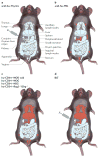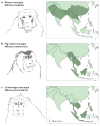Animal models for HIV/AIDS research
- PMID: 23154262
- PMCID: PMC4334372
- DOI: 10.1038/nrmicro2911
Animal models for HIV/AIDS research
Abstract
The AIDS pandemic continues to present us with unique scientific and public health challenges. Although the development of effective antiretroviral therapy has been a major triumph, the emergence of drug resistance requires active management of treatment regimens and the continued development of new antiretroviral drugs. Moreover, despite nearly 30 years of intensive investigation, we still lack the basic scientific knowledge necessary to produce a safe and effective vaccine against HIV-1. Animal models offer obvious advantages in the study of HIV/AIDS, allowing for a more invasive investigation of the disease and for preclinical testing of drugs and vaccines. Advances in humanized mouse models, non-human primate immunogenetics and recombinant challenge viruses have greatly increased the number and sophistication of available mouse and simian models. Understanding the advantages and limitations of each of these models is essential for the design of animal studies to guide the development of vaccines and antiretroviral therapies for the prevention and treatment of HIV-1 infection.
Conflict of interest statement
The authors declare no competing financial interests.
Figures




References
-
- Gao F, et al. Origin of HIV-1 in the chimpanzee Pan troglodytes troglodytes. Nature. 1999;397:436–441. - PubMed
-
- Alter HJ, et al. Transmission of HTLV-III infection from human plasma to chimpanzees: an animal model for AIDS. Science. 1984;226:549–552. - PubMed
-
- O’Neil SP, et al. Progressive infection in a subset of HIV-1-positive chimpanzees. J Infect Dis. 2000;182:1051–1062. - PubMed
Publication types
MeSH terms
Substances
Grants and funding
- R37 AI095098/AI/NIAID NIH HHS/United States
- AI078788/AI/NIAID NIH HHS/United States
- AI098485/AI/NIAID NIH HHS/United States
- R01 AI078788/AI/NIAID NIH HHS/United States
- R01 AI095098/AI/NIAID NIH HHS/United States
- R21 AI087498/AI/NIAID NIH HHS/United States
- AI087498/AI/NIAID NIH HHS/United States
- R01 AI098485/AI/NIAID NIH HHS/United States
- R21 AI093255/AI/NIAID NIH HHS/United States
- P51 OD011103/OD/NIH HHS/United States
- RR000168/OD011103/OD/NIH HHS/United States
- P51 RR000168/RR/NCRR NIH HHS/United States
- K26 RR000168/RR/NCRR NIH HHS/United States
- AI093255/AI/NIAID NIH HHS/United States
- AI095098/AI/NIAID NIH HHS/United States
LinkOut - more resources
Full Text Sources
Other Literature Sources
Medical

